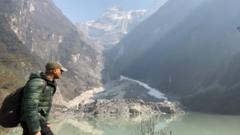The majestic Himalayas, once a prominent backdrop to life in Nepal, are increasingly concealed by a persistent haze attributed to rising air pollution levels. Residents and local businesses are feeling the impact, as the haze consistently hampers visibility, particularly from popular vantage points around Kathmandu and trekking areas such as Annapurna. Tour guides, like Lucky Chhetri, report significant drops in tourists, with some operators facing decreases as severe as 40%.
Historical weather patterns that once offered clear skies in spring months are shifting. Climate change has prolonged the dry seasons, allowing hazardous pollutants—resulting from vehicular emissions and agricultural practices—to stagnate in the air. As a result, even peak viewing times now yield disappointingly obscured views. Anecdotes from tourists only underscore the frustration, as visitors express feelings of letdown, contrasting their current experiences with the clearer vistas of a decade ago.
Pollution across South Asia continues to rise, with cities here ranking among the most polluted globally. Dust, smoke, and harsh weather conditions combine to form a stubborn haze, further veiling the beauty of the mountains. Experts have noted a staggering increase in hazy days in Nepal's Pokhara airport, spiking from merely 23 hazy days in 2020 to 168 hazy days in 2024.
The decline in visibility not only puts a strain on local tourism but deeply affects the sense of cultural identity tied to the iconic Himalayas. With the possibility of the majestic peaks becoming increasingly rare sights, business operators are left struggling with a complicated mix of loss, guilt, and helplessness in the face of an environmental crisis.
As air quality worsens, the visibility of the Himalayas hangs by a precarious thread, turning what was once a thriving spectacle for many into a challenging reality for locals and visitors alike. The Himalayas, renowned throughout history, may now mostly exist in photographs, leaving many to mourn the beauty lost beneath thickening layers of haze.
Historical weather patterns that once offered clear skies in spring months are shifting. Climate change has prolonged the dry seasons, allowing hazardous pollutants—resulting from vehicular emissions and agricultural practices—to stagnate in the air. As a result, even peak viewing times now yield disappointingly obscured views. Anecdotes from tourists only underscore the frustration, as visitors express feelings of letdown, contrasting their current experiences with the clearer vistas of a decade ago.
Pollution across South Asia continues to rise, with cities here ranking among the most polluted globally. Dust, smoke, and harsh weather conditions combine to form a stubborn haze, further veiling the beauty of the mountains. Experts have noted a staggering increase in hazy days in Nepal's Pokhara airport, spiking from merely 23 hazy days in 2020 to 168 hazy days in 2024.
The decline in visibility not only puts a strain on local tourism but deeply affects the sense of cultural identity tied to the iconic Himalayas. With the possibility of the majestic peaks becoming increasingly rare sights, business operators are left struggling with a complicated mix of loss, guilt, and helplessness in the face of an environmental crisis.
As air quality worsens, the visibility of the Himalayas hangs by a precarious thread, turning what was once a thriving spectacle for many into a challenging reality for locals and visitors alike. The Himalayas, renowned throughout history, may now mostly exist in photographs, leaving many to mourn the beauty lost beneath thickening layers of haze.


















